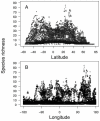Global diversity hotspots and conservation priorities for sharks
- PMID: 21573162
- PMCID: PMC3088674
- DOI: 10.1371/journal.pone.0019356
Global diversity hotspots and conservation priorities for sharks
Abstract
Sharks are one of the most threatened groups of marine animals, as high exploitation rates coupled with low resilience to fishing pressure have resulted in population declines worldwide. Designing conservation strategies for this group depends on basic knowledge of the geographic distribution and diversity of known species. So far, this information has been fragmented and incomplete. Here, we have synthesized the first global shark diversity pattern from a new database of published sources, including all 507 species described at present, and have identified hotspots of shark species richness, functional diversity and endemicity from these data. We have evaluated the congruence of these diversity measures and demonstrate their potential use in setting priority areas for shark conservation. Our results show that shark diversity across all species peaks on the continental shelves and at mid-latitudes (30-40 degrees N and S). Global hotspots of species richness, functional diversity and endemicity were found off Japan, Taiwan, the East and West coasts of Australia, Southeast Africa, Southeast Brazil and Southeast USA. Moreover, some areas with low to moderate species richness such as Southern Australia, Angola, North Chile and Western Continental Europe stood out as places of high functional diversity. Finally, species affected by shark finning showed different patterns of diversity, with peaks closer to the Equator and a more oceanic distribution overall. Our results show that the global pattern of shark diversity is uniquely different from land, and other well-studied marine taxa, and may provide guidance for spatial approaches to shark conservation. However, similar to terrestrial ecosystems, protected areas based on hotspots of diversity and endemism alone would provide insufficient means for safeguarding the diverse functional roles that sharks play in marine ecosystems.
Conflict of interest statement
Figures



References
-
- Margules CR, Pressey RL. Systematic conservation planning. Nature. 2000;405:243–253. - PubMed
-
- Hughes TP, Bellwood DR, Connolly SR. Biodiversity hotspots, centres of endemicity, and the conservation of coral reefs. Ecol Lett. 2002;5:775–784.
-
- Grenyer R, Orme CDL, Jackson SF, Thomas GH, Davies RG, et al. Global distribution and conservation of rare and threatened vertebrates. Nature. 2006;444:93–96. - PubMed
-
- Kareiva P, Marvier M. Conserving biodiversity coldspots. Am Sci. 2003;91:344–351.
-
- Camhi MD, Valenti SV, Fordham SV, Fowler SL, Gibson C. The conservation status of pelagic sharks and rays. Newbury: IUCN Species Survival Commission Shark Specialist Group; 2009. 78
Publication types
MeSH terms
LinkOut - more resources
Full Text Sources

